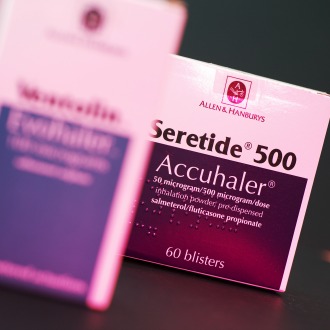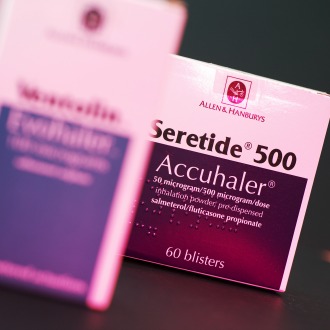Inhaled steroids in COPD: a classic case of overtreatment?

New international guidelines are advising greater caution with the use of steroid inhalers following publication of a raft of new studies.Experts in respiratory medicine are calling for an overhaul of the management of patients with COPD in primary care.

Seretide inhaler – online
Source: Julian Claxton
Leading UK respiratory clinicians say GPs should start reviewing all COPD patients and consider taking those using inhaled steroids off the drugs. This could involve at least 500,000 individuals.
But other GP experts point out that decision would require careful assessment – in particular to check for overlapping asthma – and say access to non-pharmacological alternatives, such as exercise and stop smoking support, is lacking in some areas.
The guidelines from the Global Initiative for Obstructive Lung Disease (GOLD)1 say GPs should ignore how severely patients’ lungs are damaged when deciding what drugs to offer them, and instead focus purely on breathlessness and frequency of exacerbations to optimise therapy.
This marks a departure from previous advice, including the current NICE guidelines which continue to promote use of inhaled corticosteroid (ICS) therapy if patients have severe airflow limitation (see box).
It comes amid growing concerns about steroid overuse in COPD. Professor David Halpin, honorary associate professor at the Royal Devon and Exeter Hospital and GOLD board member, says the new GOLD approach means even fewer patients should be considered eligible for ICS therapy in the first place, and that GPs should start reviewing all their stable COPD patients using steroid inhalers at the next opportunity.
One recent study3 showed more than half of patients with COPD were started on an ICS inhaler and, as many more will have therapy stepped up, Professor Halpin says this means reviewing in excess of half a million patients – most of whom could probably be taken off steroid therapy.
He says: ‘Studies have shown up to 40% of COPD patients are overtreated with ICS, and given the total number of people with COPD a figure of half a million overtreated is a reasonable estimate.’
Professor Halpin adds that the NICE guidance is seven years old, and GPs should be reviewing ICS use in line with the new guidance at their patients’ next annual review.
‘It would be worth identifying people on inhaled steroids, looking at their exacerbation history and deciding if there is an indication to continue them and if there isn’t, consider withdrawing it in a controlled manner,’ he says.
It comes amid mounting evidence that steroids are less effective in COPD than previously thought and also more harmful – in particular by increasing the risk of pneumonia, as well as other side-effects such as worsening diabetes and reduced bone density.
Yet a recent study highlighted that large numbers of patients with mild or moderate COPD end up on triple therapy with two long-acting bronchodilators and an ICS – treatment that the GOLD guidelines say should be reserved for those with the most severe disease.
Recent audits of COPD care in England and Wales, published by the Royal College of Physicians, have highlighted underuse of non-pharmacological interventions such as smoking cessation and pulmonary rehabilitation5, while UK researchers have found the NHS is losing around £100m a year due to almost 40% of COPD patients being ‘over-treated’ with ICS inhalers.6
In the light of this, medicines management teams in some areas have set up schemes to reduce ICS prescribing in COPD as part of cost-cutting drives. A scheme run by CCGs in London, designed to cut use of high-dose ICS combination inhalers in both asthma and COPD, reduced their use by nearly 9%, contributing to a £2m cut in prescribing costs per month in 2015/16.7
However, there are concerns about such moves. Dr Mark Levy, a GPSI in respiratory medicine in north-west London, fears this type of initiative carries a risk that some patients with overlapping asthma could have their steroid withdrawn inappropriately because their asthma does not get picked up. ‘There should be a health warning with reducing or stopping inhaled steroids, making 100% sure the person doesn’t have mixed disease with asthma before doing so,’ Dr Levy says.
Others also caution that there is uncertainty over the best approach to stepping down ICS therapy. Dr Kevin Gruffydd-Jones, RCGP clinical lead for respiratory medicine, says: ‘We still really don’t know quite what the best way to withdraw steroids is, because so far it has been done in different ways.’
One barrier to stepping down therapy is that it is often started because of a lack of alternatives. Dr Gruffydd-Jones adds: ‘Pulmonary rehabilitation has not been freely available in a timely manner. Waiting lists can be several months, so as a GP what are you going to do? You feel you have got to try something and end up escalating the treatment.’
A number of GP experts also caution that the GOLD strategy is based on experts’ consensus view on trial evidence – rather than the kind of independent literature appraisal carried out by NICE – and as such is favoured by the pharma industry, which is currently keen to push newly licensed inhalers combining long-acting ß2 agonists and long-acting muscarinic antagonists.
Dr Steve Holmes, education lead for the Primary Care Respiratory Society and a GPSI in respiratory medicine in Somerset, says that, while he supports efforts to reduce high-dose steroid combination therapy, he is less certain about how many patients can be safely assumed to have no future exacerbation risk over the long term.
Dr Holmes says: ‘It is only those with no exacerbations at all that would fit into the group in whom no steroid is needed. The evidence shows that, on average, patients have 0.8 exacerbations per year. On this basis – and of course GPs manage people over years, not just when they are newly diagnosed – many will have an exacerbation over the course of a few years.’
All this leaves GPs in a tricky situation as to which approach to take. Primary Care Respiratory Society chair Dr Noel Baxter suggests GPs need a pragmatic solution, especially as the GOLD guidance is a ‘very long document’ and ‘most GPs won’t have time to digest it’.
He says: ‘I would hope respiratory specialists and generalists will come together to make a concise, GP-relevant guideline using what we now have from GOLD, NICE and our UK respiratory societies.’
Differences between the new GOLD guidelines and current NICE guidelines
GOLD1
- Advises GPs to focus on patients’ symptoms and exacerbation history
- Recommends use of a ‘quadrant tool’ to guide management, with four risk categories labelled A to D, defined by patients’ symptoms and exacerbation history
- The assessment of airflow limitation is considered separately and not referred to for the purposes of pharmacological treatment, except for certain patients with very severe disease
- Recommends adding LAMA on top of LABA therapy in patients with ongoing exacerbations, in preference to adding ICS
NICE2
- Advises GPs to base decisions relating to use of inhaled corticosteroid (ICS) therapy on the degree of airflow limitation (as indicated by FEV1)
- Recommends for people with stable COPD who remain breathless or have exacerbations despite use of short-acting bronchodilators as required, the following maintenance therapy:
- FEV1 ≥50% predicted: either a long-acting ß2 agonist (LABA) or long-acting muscarinic antagonist (LAMA)
- FEV1 <50% predicted: either LABA with an ICS in a combination inhaler (LABA+ICS), or LAMA
References
1 GOLD, 2017. Global Strategy for the Diagnosis, Management and Prevention of COPD. tinyurl.com/gu85rmb
2 NICE CG101. COPD in over-16s: diagnosis and management, 2010. tinyurl.com/NICE-CG101
3 Price D et al. First maintenance therapy for COPD in the UK between 2009 and 2012: a retrospective database analysis. NPJ Prim Care Respir Med 2016; online 3 Nov. tinyurl.com/hagdzev
4 Haughney J et al. The distribution of COPD in UK general practice using the new GOLD classification. Eur Respir J 2014;43:993–1002.
tinyurl.com/zfg2eou
5 Royal College of Physicians, 2016. National COPD Audit Programme: primary care workstream.
tinyurl.com/haqml5z
6 White P et al. Overtreatment of COPD with inhaled corticosteroids. Implications for safety and costs: cross-sectional observational study. PLoS ONE 8: e75221.
tinyurl.com/z4rcrbk
7 Mak V and D’Ancona G. Avoiding inappropriate prescribing of high dose inhaled corticosteroid combination inhalers – is the message getting through? Thorax 2016;71 (Suppl 3):A118-A119. tinyurl.com/Thorax-ICS
Pulse July survey
Take our July 2025 survey to potentially win £1.000 worth of tokens

Visit Pulse Reference for details on 140 symptoms, including easily searchable symptoms and categories, offering you a free platform to check symptoms and receive potential diagnoses during consultations.












